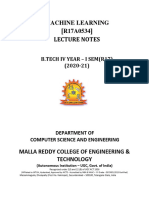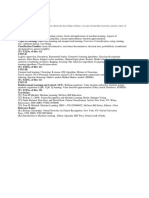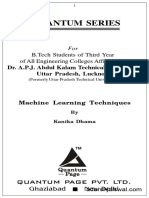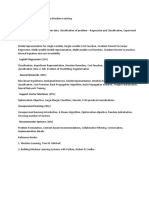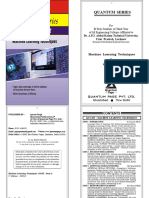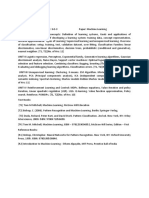Semester –VI
Advanced Machine Learning
BTAIC602 Advanced Machine Learning PCC8 3L- 0T - 0P 3 Credits
Teaching Scheme Examination Scheme
Lecture: 3 hrs./week Continuous Assessment : 20 Marks
Mid Semester Exam: 20 Marks
End Semester Exam: 60 Marks (Duration 03 hrs.)
Pre-Requisites: Machine Learning Basics, Python Programming Language.
Course Objectives:
After completion of the course, students will learn:-
To understand fundamental concepts of unsupervised learning and its various
algorithms
To understand Association Rules Mining and Recommendation Systems
To apply ML algorithms on given data and interpret the results obtained
To design appropriate ML solution to solve real world problems in AI domain
Course Outcomes:
On completion of the course, students will be able to:
CO1 Develop a good understanding of fundamental of unsupervised learning.
CO2 Formulation of Association Rules Mining and Recommendation Systems
CO3 Interpret a model using Reinforcement Learning.
CO4 Evaluate the time series data.
CO5 Design and Concrete implementations using boosting.
Course Contents:
Unit No 1: Unsupervised Learning [7 Hours]
Unsupervised Learning - 1
Introduction to Unsupervised Learning, Introduction to Clustering, Using K-means for Flat
Clustering, KMeans Algorithm, Using KMeans from Sklearn, Implementing Fit & Predict
Functions, Implementing K-Means Class
Unsupervised Learning - 2
How to choose Optimal K, Silhouette algorithm to choose K, Introduction to K Medoids, K
Medoids Algorithm, Introduction to Hierarchical Clustering, Top down/Divisive Approach,
Bottom up/Divisive Approach
Principal Component Analysis PCA
Intuition behind PCA, Applying PCA to 2D data, Applying PCA on 3D data, Math behind
PCA, Finding Optimal Number of Features, Magic behind PCA, Dimensionality reduction
PCA - 2
PCA on Images, PCA on Olevitti Images, Reproducing Images, Eigenfaces, Classification of
LFW Images
� Unit No 2: Association Rules Mining and Recommendation Systems [7 Hours]
What are Association Rules, Association Rule Parameters, Calculating Association Rule
Parameters, Recommendation Engines, Recommendation Engines working, Collaborative
Filtering ,Content Based Filtering.
Unit No 3: Reinforcement Learning [8 Hours]
What is Reinforcement Learning, Why Reinforcement Learning, Elements of Reinforcement
Learning, Exploration vs Exploitation dilemma, Epsilon Greedy Algorithm, Markov Decision
Process (MDP), Q values and V values, Q – Learning, 𝛼 values.
Unit No 4: Time Series Analysis [7 Hours]
Time Series Analysis ,Importance of TSA ,Components of TSA,White Noise, AR model, MA
model,ARMA model,ARIMA model,Stationarity,ACF & PACF
Unit No 5: Model Selection and Boosting [7 Hours]
Model Selection, Need of Model Selection, Cross – Validation, Boosting, Boosting
Algorithms, Types of Boosting Algorithms, Adaptive Boosting.
Text Books:
1. Ethem Alpaydın, Introduction to Machine Learning, PHI, Third Edition, ISBN No. 978-81-203-
5078-6
2. Christopher M. Bishop, Pattern Recognition and Machine Learning, Mcgraw-Hill, ISBN No. 0- 07-
115467-1
3. Tom Mitchell, Machine Learning, Mcgraw-Hill, First Edition, ISBN No. 0-07-115467-1.
4.Giuseppe Bonaccorso, “Machine Learning Algorithms”, Packt Publishing Limited, ISBN10:
1785889621, ISBN-13: 978-1785889622
Reference Books:
1.R.O. Duda, P.E. Hart, D.G. Stork, Pattern Classification, 2/e, Wiley, 2001
2. Shai shalev-Shwartz and Shai Ben-David, Understanding Machine Learning(From Theory to
Algorithms), Cambridge University Press, First Edition, ISBN No. 978-1-107-51282-5.
3. A. Rostamizadeh, A. Talwalkar, M. Mohri, Foundations of Machine Learning, MIT Press.
4. A. Webb, Statistical Pattern Recognition, 3/e, Wiley, 2011.










